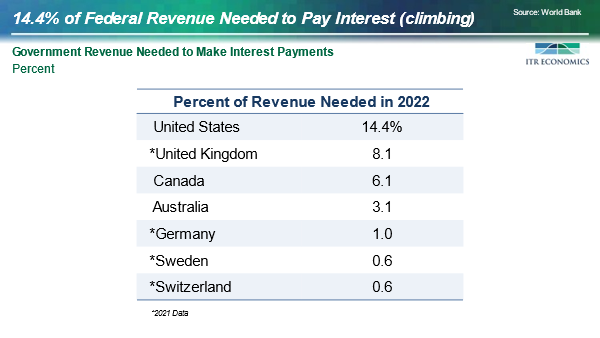We are looking at the fifth and final aspect of the Financial Bunker that we suggest you have in place by 2028-2029.

As a reminder, there are three primary reasons for creating the Financial Bunker. The prior four items discussed are also provided below.
3 Reasons why you want to have a Financial Bunker
- Peace of mind going into a tumultuous time.
- Positioning yourself to create wealth through the 2030s.
- Cash is king at the bottom of a business cycle.

Why Have a Strong Tax Advisor
Our thinking is straightforward; a) the government needs more and more money, and b) a “redistribution of wealth” during a depression is a logical approach for the government because it is easier than making “painful” cuts in spending.
The chart below shows that our national debt as a percent of GDP has been generally rising since the early 1980s (the modern-era exception was President Clinton). This general rising trend has been in place for over 40 years, and we do not see how it will not keep going up when you combine government involvement in health care, demographics, entitlement program spending, and the body politic. Our GDP will not be rising in a significant portion of the 2030s. Notice from the chart that the percentage climbs faster during times of economic distress.
The quest for “more” will not abate during tough economic times unless there is a watershed change in our culture and in our political thinking. The period following WWII through the 1970s shows that we were once on a quest to lower the threshold of debt (the debt itself generally kept rising). A similar change is always possible; however, we do not think it is probable before an economic crisis is upon us.

The table below compares the US to other countries regarding how big a bite out of federal government revenues we need to simply pay interest on the national debt. It takes 14.4% of the federal government’s revenues to pay the interest. The percentage is increasing because the debt is getting larger and because interest rates are going higher.
The US is going to encounter a more voracious need to get hold of tax dollars to pay the interest on debt already incurred and fund all the other programs than will each of the other countries on the table. The fact that Sweden and Switzerland are so low on the list is another reason they make it onto our “safe haven” list of economies as we look into the 2030s.

The US is the largest economy on the planet. It offers possibilities and potential for the future that few economies can come close to matching. However, as a government and perhaps as a culture, we are addicted to debt. There is an eventual price to pay when you are dangerously addicted.
Join us on December 17, 2024, for our 2030s Depression Executive Series online seminar to learn more on this subject.
If you would like to join us, you can purchase your seat here.